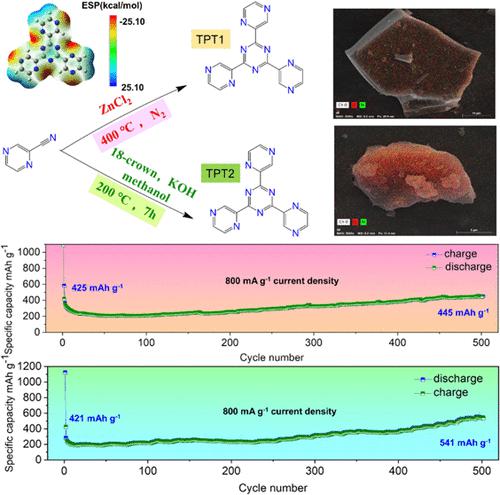当前位置:
X-MOL 学术
›
ACS Sustain. Chem. Eng.
›
论文详情
Our official English website, www.x-mol.net, welcomes your
feedback! (Note: you will need to create a separate account there.)
Synthesis of Nitrogen-Conjugated 2,4,6-Tris(pyrazinyl)-1,3,5-triazine Molecules and Electrochemical Lithium Storage Mechanism
ACS Sustainable Chemistry & Engineering ( IF 7.1 ) Pub Date : 2023-06-13 , DOI: 10.1021/acssuschemeng.3c00982 Yan Deng 1 , Qi-Ling Li 1 , Yu-Qing Cai 1 , Xian-Feng Ye 1 , Wen Pu 1 , Li-Feng Yao 1, 2 , Jian-Jun Liu 1 , Shu-Biao Xia 1
ACS Sustainable Chemistry & Engineering ( IF 7.1 ) Pub Date : 2023-06-13 , DOI: 10.1021/acssuschemeng.3c00982 Yan Deng 1 , Qi-Ling Li 1 , Yu-Qing Cai 1 , Xian-Feng Ye 1 , Wen Pu 1 , Li-Feng Yao 1, 2 , Jian-Jun Liu 1 , Shu-Biao Xia 1
Affiliation

|
Organic anode materials for lithium-ion battery have attracted widespread attention due to their diversity in organic linker functional species and the ability to tune their molecular levels. However, the rational design of advanced organic anodes with high reversible capacity and intentional organic molecular design requires a deep understanding of their mechanism for use in small-molecule organic rechargeable batteries. Herein, an optimized small-molecule-based organic anode material containing highly efficient active sites was developed for use in an organic lithium-ion battery. A small-molecule organic compound, 2,4,6-tris(pyrazinyl)-1,3,5-triazine (TPT), was formed by the trimerization of the 2-cyanopyrazine monomer. This molecule was rationally designed and evaluated as a lithium-ion battery organic anode material. TPT has a relatively small structure, but a superior reversible specific capacity was still achieved. Excitingly, TPT2 (liquid-phase synthetic) released a reversible capacity of 622 mAh g–1 at 100 mA g–1. Moreover, impressive long-term cycling performance was obtained, with a storage capacity of 541 mAh g–1 at 800 mA g–1 after 500 cycles. This demonstrated the durable cyclic stability of TPT2, which also achieved excellent rate performance at different current densities from 100 mA g–1 to 1.6 A g–1. The lithium storage mechanism of TPT was studied by theoretical calculations and ex situ Fourier transform infrared spectroscopy (FTIR) combined with X-ray photoelectron spectroscopy (XPS) characterization, which demonstrated that multiple active sites consisting of −C–N and −C═N groups were responsible for its superior lithium storage performance. This study provides a new understanding of the energy storage mechanism in small-molecule organic-based anode electrodes.
中文翻译:

氮共轭2,4,6-三(吡嗪基)-1,3,5-三嗪分子的合成及电化学储锂机制
用于锂离子电池的有机负极材料由于其有机连接体功能物种的多样性和调节其分子水平的能力而引起了广泛的关注。然而,合理设计具有高可逆容量的先进有机阳极和有意的有机分子设计需要深入了解其在小分子有机可充电电池中的使用机理。在此,开发了一种包含高效活性位点的优化的小分子有机负极材料,用于有机锂离子电池。通过2-氰基吡嗪单体的三聚反应形成小分子有机化合物2,4,6-三(吡嗪基)-1,3,5-三嗪(TPT)。该分子经过合理设计并作为锂离子电池有机负极材料进行评价。TPT具有相对较小的结构,但仍然实现了优异的可逆比容量。令人兴奋的是,TPT2(液相合成)释放了622 mAh g的可逆容量–1 100 mA g –1。此外,还获得了令人印象深刻的长期循环性能,500次循环后在800 mA g –1下的存储容量为541 mAh g –1 。这证明了 TPT2 具有持久的循环稳定性,并且在 100 mA g –1至 1.6 A g –1的不同电流密度下也实现了出色的倍率性能。通过理论计算和非原位傅里叶变换红外光谱(FTIR)结合X射线光电子能谱(XPS)表征研究了TPT的储锂机理,结果表明由-C–N和-C=N组成的多个活性位点团体对其卓越的锂存储性能负责。这项研究为小分子有机阳极电极的储能机制提供了新的认识。
更新日期:2023-06-13
中文翻译:

氮共轭2,4,6-三(吡嗪基)-1,3,5-三嗪分子的合成及电化学储锂机制
用于锂离子电池的有机负极材料由于其有机连接体功能物种的多样性和调节其分子水平的能力而引起了广泛的关注。然而,合理设计具有高可逆容量的先进有机阳极和有意的有机分子设计需要深入了解其在小分子有机可充电电池中的使用机理。在此,开发了一种包含高效活性位点的优化的小分子有机负极材料,用于有机锂离子电池。通过2-氰基吡嗪单体的三聚反应形成小分子有机化合物2,4,6-三(吡嗪基)-1,3,5-三嗪(TPT)。该分子经过合理设计并作为锂离子电池有机负极材料进行评价。TPT具有相对较小的结构,但仍然实现了优异的可逆比容量。令人兴奋的是,TPT2(液相合成)释放了622 mAh g的可逆容量–1 100 mA g –1。此外,还获得了令人印象深刻的长期循环性能,500次循环后在800 mA g –1下的存储容量为541 mAh g –1 。这证明了 TPT2 具有持久的循环稳定性,并且在 100 mA g –1至 1.6 A g –1的不同电流密度下也实现了出色的倍率性能。通过理论计算和非原位傅里叶变换红外光谱(FTIR)结合X射线光电子能谱(XPS)表征研究了TPT的储锂机理,结果表明由-C–N和-C=N组成的多个活性位点团体对其卓越的锂存储性能负责。这项研究为小分子有机阳极电极的储能机制提供了新的认识。































 京公网安备 11010802027423号
京公网安备 11010802027423号